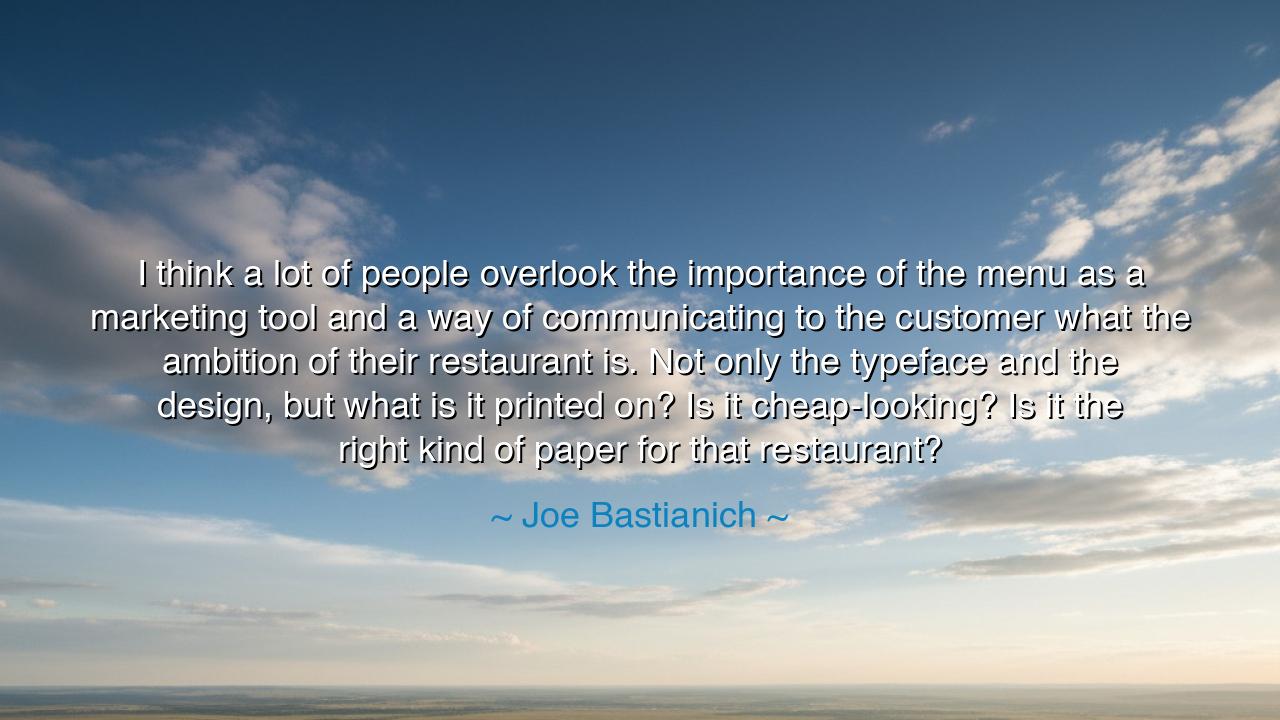
I think a lot of people overlook the importance of the menu as a
I think a lot of people overlook the importance of the menu as a marketing tool and a way of communicating to the customer what the ambition of their restaurant is. Not only the typeface and the design, but what is it printed on? Is it cheap-looking? Is it the right kind of paper for that restaurant?






“I think a lot of people overlook the importance of the menu as a marketing tool and a way of communicating to the customer what the ambition of their restaurant is. Not only the typeface and the design, but what is it printed on? Is it cheap-looking? Is it the right kind of paper for that restaurant?” Thus spoke Joe Bastianich, a modern master of the culinary arts, whose wisdom transcends the kitchen and enters the realm of philosophy. In these words, he reminds us that even the simplest object—the menu—is a vessel of meaning. It is not merely a list of dishes; it is the soul of the restaurant made visible, a silent dialogue between the creator and the guest. Through paper, type, and form, the chef speaks: This is who we are. This is what we aspire to be.
In the age of haste, many see the menu as an afterthought, a necessity rather than an art. But Bastianich’s insight reveals a deeper truth: that design is communication, and that every detail tells a story. The typeface, the texture of the paper, the simplicity or grandeur of its layout—these are not accidents but declarations. They whisper to the diner long before the first taste reaches the tongue. A fine restaurant that presents a flimsy, thoughtless menu undermines its own ambition, for the message it sends is not of excellence, but of neglect. As in life, so in dining: the smallest details are often the truest mirrors of the heart.
The origin of this idea lies not in modern marketing, but in the ancient principle of harmony—the belief that form and purpose must be one. The Greeks called it kalokagathia, the union of beauty and goodness. To create well, one must ensure that the outer form reflects the inner spirit. The menu, then, is the restaurant’s first act of hospitality, its first act of truth. It invites the guest into its world. It says, “Trust us, for we have considered even this.” Bastianich, steeped in the tradition of his Italian heritage, understands that in every act of creation—be it food, music, or architecture—the visible must honor the invisible.
Consider the story of Leonardo da Vinci, who, when designing banquets for the dukes of Milan, insisted that every plate, every utensil, and even the arrangement of the table reflect the spirit of the meal. To Leonardo, the art of dining was a complete experience, where presentation and flavor were parts of one symphony. He would have understood Bastianich’s philosophy perfectly: that beauty and purpose are inseparable, and that a dish presented without thought for its setting is only half created.
In truth, Bastianich’s quote speaks not only of restaurants, but of all human endeavor. The menu becomes a symbol for everything we present to the world—our words, our actions, our craft. Every choice we make—what we wear, how we speak, how we treat others—communicates our ambition and our respect for those we serve. A careless presentation diminishes even great skill, while thoughtful attention elevates even the simplest offering. The lesson, then, is that authenticity is found not only in grand gestures, but in consistency between vision and expression.
Let us not forget that in every field—art, business, life—the audience reads more than what is written. They sense the care, the discipline, the integrity behind each detail. Just as a diner reads the soul of a restaurant in its menu, so too does the world read the soul of a person in the quality of their work. The paper, the type, the design—these are metaphors for intention. One may speak of ambition, but if the paper of one’s life is cheap and crumpled by negligence, the message will not endure.
Therefore, let Bastianich’s wisdom be taken as counsel for all who would create: nothing is too small to matter. The texture of a menu, the tone of a letter, the gesture of a greeting—all are threads in the tapestry of meaning. Care for them as you would the grand design, for the whole depends upon the parts. When form and spirit walk together, greatness follows naturally.
And so, remember this: the menu of your life is always before others. What does it say of you? Does it speak of purpose, or of carelessness? Let every act, however small, reflect your true ambition. For just as the diner knows the worth of a meal by the first touch of parchment, so the world knows the worth of a person by the unseen care in all they do.






AAdministratorAdministrator
Welcome, honored guests. Please leave a comment, we will respond soon